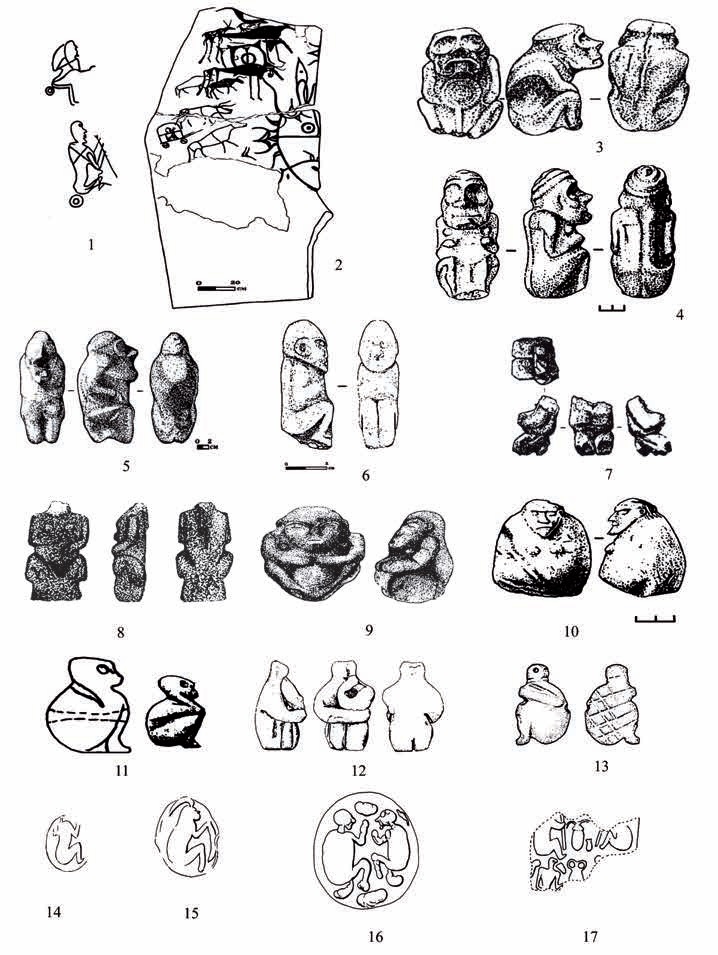«TOBOLSKY THINKER»: ABOUT INTERPRETATION OF ONE ANTHROPOMORPHOUS PERSONAGE IN THE ART OF CENTRAL ASIA IN THE ENEOLITHIC AND BRONZE AGES
DOI:
https://doi.org/10.52967/akz2020.2.8.27.35Keywords:
archaeology, Central Asia, Middle East, small sculptures, anthropomorphous figure, petroglyphs, Okunev culture, wheel transport, charioteer, seals of UrukAbstract
The article is devoted to the anthropomorphic personage of small plastic art and rock art of Central Asia, which received the provisional name "Tobolsky thinker". The author draws attention to new analogies of this anthropomorphous personage in the art of the Central and Middle East of the Eneolithic and Early Bronze Age, and also addresses the issue of ethnocultural and historical interpretation of this rare plot. The presentation of people in a sitting pose is typical of the eneolithic anthropomorphic plastics of the southern regions of Central Asia. The wide range of this image shows the ambiguity of its semantics. It is obvious that the purpose of sitting anthropomorphic figures in the art of the Eneolithic and Bronze Ages of Central Asia was varied. The naturality of the pose of a sitting person, the compactness of the image of a sitting figure, the hierarchical and professional context of this pose implies different interpretations of these artifacts despite their iconographic similarity.
References
Antonova, Ye. V. 1978. In Drevnost i srednevekoviye narodov Sredney Azii (istoriya i kultura) (To the question of the significance of poses of anthropomorphic images of the preliterate era (Middle East and Central Asia)). Moscow: „Nauka“ Publ., 5–16 (in Russian).
Baipakov, K. M., Maryashev, A. N. 2004. Petroglify v gorakh Kulzhabasy (Petroglyphs in the Kulzhabasy mountains). Almaty: „Print-S“ Publ. (in Russian).
Boehmer, R. M. 1999. In Ausgrabungen in Uruk-Warka. Endberichte; 24. Mainz: von Zabern (in German).
Vadetskaya, E. B., Leontiyev, N. V., Maksimenkov, G. A. 1980. Pamyatniki okunevskoy kultury (Monuments of Okunev culture). Leningrad: „Nauka“ Publ. (in Russian).
Leont’ev, N. V., Kapel’ko, V. F. 2002. Steinstelen der Okunev-Kultur. Archäologie in Eurasien 13. Mainz: von Zabern (in German).
Lie, Chen. 1996. In Das alte China. Menschen und Götter im Reich der Mitte, 5000 v. Chr. - 220 n. Zürich: Kunsthaus, 34–42 (in German).
Mikhailov, Y. I. 2001. In Vestnik Sibirskoy assotsiatsii issledovateley pervobytnogo iskusstva (Bulleten of Siberian Association of Primitive Art Researchers), 4, 18–20 (in English).
Novozhenov, V. A. 2015. In Beisenov, A. Z. (Ed.). Drevniy Turgay i Velikaya Step: chast i tseloye (Ancient Turgay and Great Speppe: part and whole). Kostanay; Almaty: A.Kh. Margulan Institute of Archeology, 314–331 (in Russian).
Rashad, M. 1990. Die Entwicklung der vor- und frühgeschichtlichen Stempelsiegel im Iran: im Vergleich mit Mesopotamien, Syrien und Kleinasien - von ihren Anfängen bis zum Beginn des 3. Jahrtausends v. Chr. Berlin: Reimer (in German).
Samašev, Z., Žumabekova, G. 1996. In Eurasia Antiqua, Bd. 2, 229–241 (in German).
Svend, H. 2007. Bilder vom Menschen der Steinzeit. Archäologie in Eurasien; 20. Bd 2. Mainz: von Zabern (in German).
Chenchenkova, O. P. 2004. Kamennaya skulptura lesostepnoy Azii epokhi paleometalla III–I tys. do n.e. (Stone sculpture of forest-steppe Asia of the Paleo-metal era of the III-I millennium BC). Yekaterinburg: „Tezis“ Publ. (in Russian).
Shishkin, I. B. 1981. U sten velikoy Namazgi (At the walls of the great Namazga). Moscow: „Nauka“ (in Russian).
Shkoda, V. G. 1992. In Piotrovskiy, Yu. Yu. (Ed.). Severnaya Yevraziya ot drevnosti do srednevekoviya (Eurasian Steppes of Antiquity and the Early Middle Ages), 2. Saint Petersburg: State Hermitazhe Museum, 57–59 (in Russian).
Shkoda, V. G. 1997. In Soobshcheniya GosErmitazha (Reports of State Hermitage), 48–51 (in Russian).

Downloads
Published
How to Cite
Issue
Section
License
Copyright (c) 2020 I. N. Shvets

This work is licensed under a Creative Commons Attribution-NonCommercial 4.0 International License.






